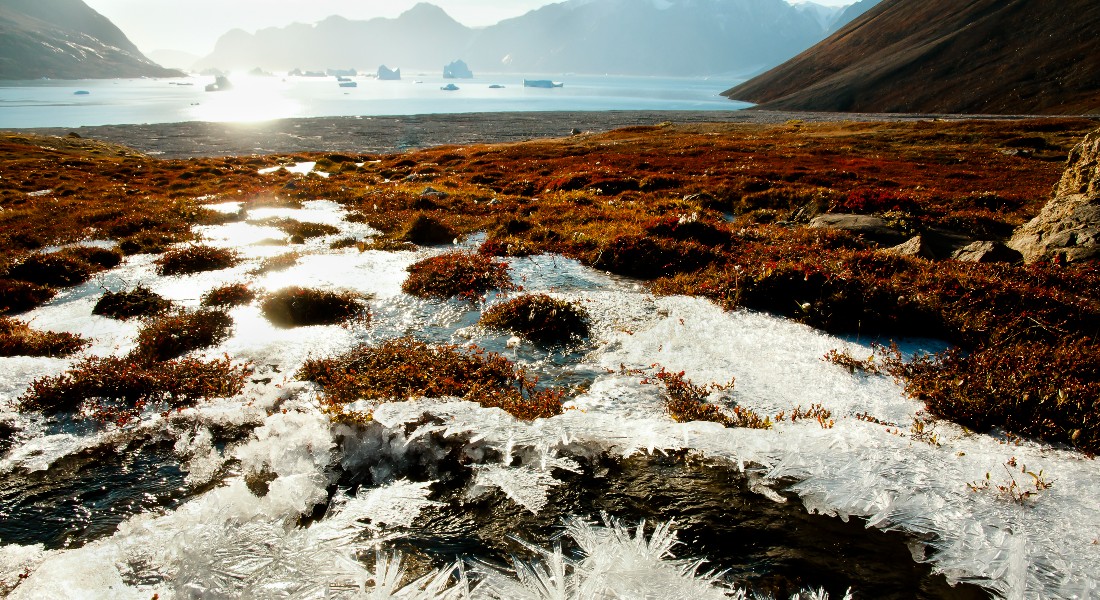Arctic vegetation has a major impact on warming
An international team of research scientists, University of Copenhagen researchers among them, has documented the central role of vegetation for Arctic warming for the first time. The new results allow us to make more precise climate predictions, with the researchers pointing out that current models remain flawed.

The Arctic is warming three times faster than the global average. In areas where snow and ice used to reflect sunlight back into the atmosphere, melted terrain now absorbs heat into the earth’s surface. There has long been speculation about the degree to which vegetation emerging from melting snow has on warming, compared to other factors like snow, precipitation, cloud cover and geographical location.
Numerous studies have already demonstrated the significance of greenhouse gas emissions, such as from CO2 and methane, in Arctic ecosystems. Far fewer have investigated the influence of vegetation on Arctic climates. Using new analyses of data measured at 64 Arctic sites from 1994-2021, an international research team has become the first to document the great importance of vegetation for Arctic warming. The study has been published in Nature Communications.
“Theoretically, it has long been understood that surface vegetation helps heat an area as plants absorb solar radiation. In our new study, we confirm this theory through actual measurements and demonstrate a correlation between the amount of energy absorbed on the surface and the types of vegetation found there,” says Professor Thomas Friborg of the Department of Geosciences and Natural Resource Management.
For more than 20 years, Friborg has measured climate data from northern Sweden, northern Russia and Greenland, among other places, and has contributed data to the study.
Theory confirmed
Among other things, the researchers compared fifteen factors that affect the so-called “surface energy budget” (SEB), which describes how solar energy is converted when it hits the earth's surface. In doing so, the researchers studied how various Arctic areas such as barren tundra, peat bogs, shrub-covered tundra and wetlands influence how solar energy is converted.
The results demonstrate that some of the greatest differences in energy conversion are found between dry areas with little vegetation, where grasses and lichens typically grow, and wet areas such as peat bogs, that are rich in mosses, shrubs and small trees. Dry soil surfaces produce greater warming than wet areas as the energy from wet areas is converted into evaporation.
This is just one example of the various roles that vegetation types play in the warming of an area, differences that today’s climate models still fail to take fully into account.
"Our study shows that the type of vegetation on an Arctic surface has a major impact on how direct warming will be. Whether there are shrubs, grasses, mosses or wetlands matters considerably for the degree to which solar energy is absorbed and how it gets converted. In fact, in some cases, vegetation type is nearly as decisive as whether snow is present," says Professor Friborg.
Crucial for climate predictions
Several studies have shown that the Arctic is greening as temperatures rise due to what is known as arctic amplification. As this leads to the emergence of more vegetation, knowing how vegetation reacts with sunlight and affects warming is crucial for climate predictions. It is here that the researchers contributed new and important knowledge.
"It is a very large study, and an important observation of the way Arctic plants convert solar energy. The results are very likely to influence our way of predicting climatic changes in the Arctic and globally, because we can now put a few values on vegetation-related differences," says Friborg.
The researchers’ findings also highlight the potential for improving our current predictions for how climate evolves. Current knowledge remains checkered, and ever more data collection is needed to understand this intricate puzzle.
“In many ways, the Arctic is the canary in the coal mine – it is where we first and most powerfully see global warming. But at the same time, it is incredibly complex to predict. We are currently witnessing warming of 3-4 degrees, which is higher than quite a few of the models predicted 20 years ago. As such, there is a constant need to refine models and include as much data as possible in them,” concludes Professor Thomas Friborg.
About the study:
- Using new analyses of data measured at 64 Arctic sites from 1994-2021, an international research team has become the first to document the great importance of vegetation for Arctic warming.
- The results demonstrate that some of the greatest differences in energy conversion are found between dry areas with little vegetation, where grasses and lichens typically grow, and wet areas such as peat bogs, that are rich in mosses, shrubs and small trees.
- UCPH provided research data for the study through, among other things, two monitoring programmes: Integrated Carbon Observation System, ICOS, (www.icos-cp.eu/) and Greenland Ecosystem Monitoring (https://g-e-m.dk/).
Contact
Thomas Friborg
Professor
Department of Geosciences and Natural Resource Management
University of Copenhagen
+45 61 30 25 74
tfj@ign.ku.dk
Michael Skov Jensen
Journalist and team coordinator
The Faculty of Science
+45 93 56 58 97
msj@science.ku.dk
